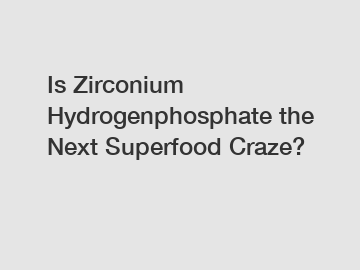How Does ultrafine iron oxide nanoparticles Work?
Ultrafine iron oxide nanoparticles are an exciting area of research in the field of nanotechnology. These tiny particles, often only a few nanometers in size, have unique properties that make them attractive for a wide range of applications, from biomedical imaging to environmental remediation. Understanding how ultrafine iron oxide nanoparticles work is crucial for harnessing their potential benefits effectively.
**Properties of Ultrafine Iron Oxide Nanoparticles**.
One of the key properties of ultrafine iron oxide nanoparticles is their high surface area-to-volume ratio. Because of their small size, these nanoparticles have a large surface area relative to their volume, which allows them to interact more effectively with other molecules or materials. This property makes them ideal for applications such as drug delivery, where the nanoparticles can be loaded with therapeutic compounds and targeted to specific cells or tissues in the body.
**Magnetic Properties**.
Another important feature of ultrafine iron oxide nanoparticles is their magnetic properties. These nanoparticles are typically made up of magnetite (Fe3O4) or maghemite (γ-Fe2O3) and exhibit strong magnetic behavior. When placed in a magnetic field, the nanoparticles become magnetized, allowing them to be manipulated and controlled with external magnets. This property is utilized in magnetic resonance imaging (MRI), where the nanoparticles are used as contrast agents to enhance the visibility of specific tissues or organs in the body.
**Thermal and Optical Properties**.
In addition to their magnetic properties, ultrafine iron oxide nanoparticles also exhibit unique thermal and optical properties. These nanoparticles can absorb and release energy in the form of heat when exposed to particular wavelengths of light, a phenomenon known as photothermal conversion. This property is exploited in cancer therapy, where the nanoparticles are used to selectively heat and destroy cancer cells when activated by laser light.
**Applications of Ultrafine Iron Oxide Nanoparticles**.
Additional resources:Exploring Colloidal Silver: Uses, Safety, and Side Effects
What are the benefits of using Hpmc K100m?
How to Choose Boric Acid for Cleaning
What is the use of HPMC in detergent?
What are the types of cell culture consumables ?
What Are Peptides, and How Can They Improve Your Health?
Difference between drug substance and drug product
The versatility of ultrafine iron oxide nanoparticles has made them valuable tools in various fields. In biomedicine, these nanoparticles are used for targeted drug delivery, magnetic hyperthermia, and diagnostic imaging. In environmental science, they are employed for contaminant remediation, wastewater treatment, and pollutant detection. In materials science, they find applications in magnetic data storage, catalysis, and sensing.
**Challenges and Future Directions**.
Despite their promising potential, there are still challenges to overcome in the development and utilization of ultrafine iron oxide nanoparticles. Issues such as biocompatibility, stability, and cost-effectiveness need to be addressed to ensure the safe and effective use of these nanoparticles in practical applications. Ongoing research is focused on improving the synthesis methods, surface modification, and functionalization of the nanoparticles to overcome these challenges.
**Conclusion**.
In conclusion, ultrafine iron oxide nanoparticles are remarkable nanomaterials with a wide range of unique properties that make them valuable in various applications. Understanding how these nanoparticles work is essential for unlocking their full potential and maximizing their benefits. As research in nanotechnology continues to progress, we can expect to see even more exciting developments and innovations in the field of ultrafine iron oxide nanoparticles.
If you have any questions about how ultrafine iron oxide nanoparticles work or would like to learn more about their applications, feel free to contact us.
Want more information on uiv chem silica magnetic beads, Nano Silver Paste, nano silver powder suppliers? Feel free to contact us.
Additional resources:What is Hydroxy Ethyl Cellulose (HEC)?
Introduction to CAS 2381089-83-2 LY3437943 Wholesale high purity
What Does Praziquantel Treat in Animals?
What is nano powder used for?
How to make custom stickers and decals
What is the cost of printing stickers?
What is hydroxypropyl methyl cellulose used for?







Comments
0